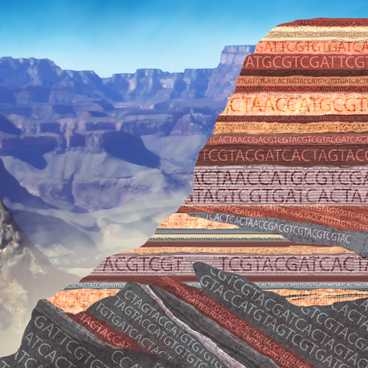About 580 million years ago, life on Earth entered a rapid period of change called the Cambrian Explosion, a period defined by the birth of new life forms over many millions of years that ultimately helped bring about the modern diversity of animals. Fossils help palaeontologists chronicle the evolution of life since then, but drawing a picture of life during the 3 billion years that preceded the Cambrian Period is challenging, because the soft-bodied Precambrian cells rarely left fossil imprints. However, those early life forms did leave behind one abundant microscopic fossil: DNA.
Because any living organism inherits its genome — the entire package of hereditary information existing in an organism’s DNA and RNA — from ancestral genomes, computational biologists at MIT reasoned that they could use modern-day genomes to reconstruct the evolution of ancient microbes. They combined information from the ever-growing genome library with their own mathematical model that takes into account the ways that genes evolve: New gene families can be born and inherited; genes can be swapped or horizontally transferred between organisms; genes can be duplicated in the same genome; and genes can be lost.
The scientists traced thousands of genes from 100 modern genomes back to those genes’ first appearance on Earth to create a genomic fossil telling not only when genes came into being but also which ancient microbes possessed those genes. The work, reported in the Dec. 19 online issue of Nature, suggests that the collective genome of all life underwent an expansion between 3.3 and 2.8 billion years ago, during which time 27 percent of all presently existing gene families came into being.
Eric Alm, a professor in the Department of Civil and Environmental Engineering and the Department of Biological Engineering, and Lawrence David, who recently received his PhD from MIT and is now a Junior Fellow in the Harvard Society of Fellows, have named this period the Archean Expansion.
Because so many of the new genes they identified are related to oxygen, Alm and David first thought that the emergence of oxygen might be responsible for the Archean Expansion. Oxygen did not exist in the Earth’s atmosphere until about 2.5 billion years ago when it began to accumulate, likely killing off vast numbers of anaerobic life forms in the Great Oxidation Event.
“The Great Oxidation Event was probably the most catastrophic event in the history of cellular life, but we don’t have any biological record of it,” says Alm.
Closer inspection, however, showed that oxygen-utilizing genes didn’t appear until the tail end of the Archean Expansion 2.8 billion years ago, which is more consistent with the date geochemists assign to the Great Oxidation Event.
Instead, Alm and David believe they’ve detected the birth of modern electron transport, the biochemical process responsible for shuttling electrons within cellular membranes. All organisms that breathe oxygen use electron transport to do so, while plants and some microbes use electron transport during photosynthesis when they harvest energy directly from the sun. A form of photosynthesis called oxygenic photosynthesis is believed to be responsible for generating the oxygen associated with the Great Oxidation Event, and is responsible for the oxygen we breathe today.
The evolution of electron transport during the Archean Expansion would have enabled several key stages in the history of life, including photosynthesis and respiration, both of which could lead to much larger amounts of energy being harvested and stored in the biosphere.
“Our results can’t say if the development of electron transport directly caused the Archean Expansion,” says David. “Nonetheless, we can speculate that having access to a much larger energy budget enabled the biosphere to host larger and more complex microbial ecosystems.”
The scientists went on to investigate how microbial genomes evolved after the Archean Expansion by looking at the metals and molecules associated with the genes and how those changed in abundance over time. They found an increasing percentage of genes using oxygen, and enzymes associated with copper and molybdenum, which is consistent with the geological record of evolution.
“David and Alm have integrated genomics and phylogenetics in an innovative and stimulating way, shedding welcome light on the early evolution of life,” says Andrew Knoll, a Harvard professor of natural history whose own research focus is Archean and Proterozoic paleontology and biogeology. “Hearteningly to Earth scientists, they paint a picture of metabolic evolution quite consistent with geologic expectation.”
Alm says the findings “prove that the histories of very ancient events are recorded in the shared DNA of living organisms.” With scientists now beginning to understand how to decode that history, he says he is hopeful that some of the earliest events in the evolution of life can be reconstructed in great detail.
Because any living organism inherits its genome — the entire package of hereditary information existing in an organism’s DNA and RNA — from ancestral genomes, computational biologists at MIT reasoned that they could use modern-day genomes to reconstruct the evolution of ancient microbes. They combined information from the ever-growing genome library with their own mathematical model that takes into account the ways that genes evolve: New gene families can be born and inherited; genes can be swapped or horizontally transferred between organisms; genes can be duplicated in the same genome; and genes can be lost.
The scientists traced thousands of genes from 100 modern genomes back to those genes’ first appearance on Earth to create a genomic fossil telling not only when genes came into being but also which ancient microbes possessed those genes. The work, reported in the Dec. 19 online issue of Nature, suggests that the collective genome of all life underwent an expansion between 3.3 and 2.8 billion years ago, during which time 27 percent of all presently existing gene families came into being.
Eric Alm, a professor in the Department of Civil and Environmental Engineering and the Department of Biological Engineering, and Lawrence David, who recently received his PhD from MIT and is now a Junior Fellow in the Harvard Society of Fellows, have named this period the Archean Expansion.
Because so many of the new genes they identified are related to oxygen, Alm and David first thought that the emergence of oxygen might be responsible for the Archean Expansion. Oxygen did not exist in the Earth’s atmosphere until about 2.5 billion years ago when it began to accumulate, likely killing off vast numbers of anaerobic life forms in the Great Oxidation Event.
“The Great Oxidation Event was probably the most catastrophic event in the history of cellular life, but we don’t have any biological record of it,” says Alm.
Closer inspection, however, showed that oxygen-utilizing genes didn’t appear until the tail end of the Archean Expansion 2.8 billion years ago, which is more consistent with the date geochemists assign to the Great Oxidation Event.
Instead, Alm and David believe they’ve detected the birth of modern electron transport, the biochemical process responsible for shuttling electrons within cellular membranes. All organisms that breathe oxygen use electron transport to do so, while plants and some microbes use electron transport during photosynthesis when they harvest energy directly from the sun. A form of photosynthesis called oxygenic photosynthesis is believed to be responsible for generating the oxygen associated with the Great Oxidation Event, and is responsible for the oxygen we breathe today.
The evolution of electron transport during the Archean Expansion would have enabled several key stages in the history of life, including photosynthesis and respiration, both of which could lead to much larger amounts of energy being harvested and stored in the biosphere.
“Our results can’t say if the development of electron transport directly caused the Archean Expansion,” says David. “Nonetheless, we can speculate that having access to a much larger energy budget enabled the biosphere to host larger and more complex microbial ecosystems.”
The scientists went on to investigate how microbial genomes evolved after the Archean Expansion by looking at the metals and molecules associated with the genes and how those changed in abundance over time. They found an increasing percentage of genes using oxygen, and enzymes associated with copper and molybdenum, which is consistent with the geological record of evolution.
“David and Alm have integrated genomics and phylogenetics in an innovative and stimulating way, shedding welcome light on the early evolution of life,” says Andrew Knoll, a Harvard professor of natural history whose own research focus is Archean and Proterozoic paleontology and biogeology. “Hearteningly to Earth scientists, they paint a picture of metabolic evolution quite consistent with geologic expectation.”
Alm says the findings “prove that the histories of very ancient events are recorded in the shared DNA of living organisms.” With scientists now beginning to understand how to decode that history, he says he is hopeful that some of the earliest events in the evolution of life can be reconstructed in great detail.






